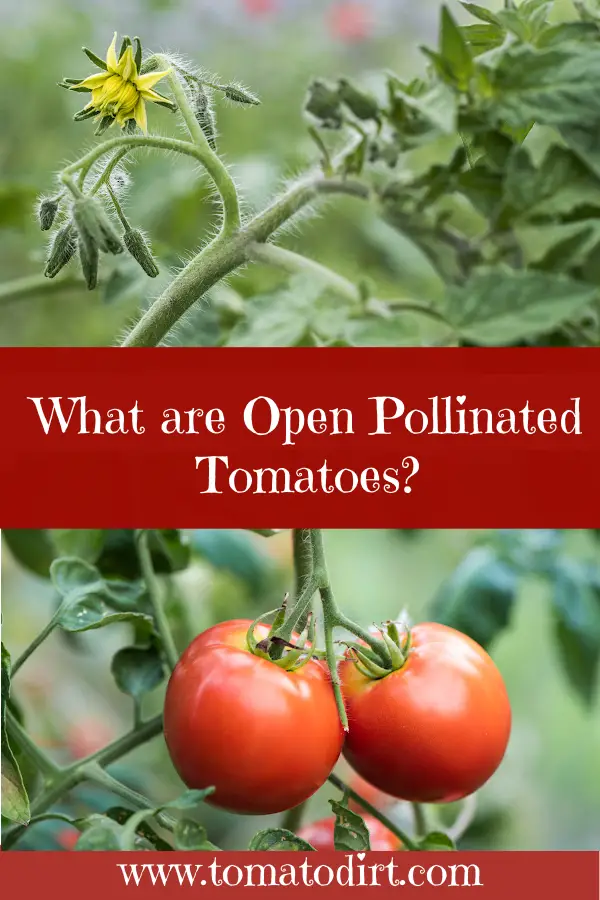FREE: 10 Must-Know Tomato Growing Tips Get The Guide
Read our affiliate disclosure here.
What Are Open Pollinated Tomatoes?
Since 2010, Tomato Dirt has garnered 4.8+ million views, making it the web’s leading online source for growing tomatoes in the home garden. Award-winning writer and Tomato Dirt owner Kathy Widenhouse has helped thousands of home gardeners grow healthier tomatoes. Be one of them when you get Tomato Dirt’s Growing Guide here.
Updated 1.5.25
Open pollinated tomatoes … heirloom tomatoes … hybrid tomatoes. Those terms may be confusing.
I’ll explain the differences in a minute. But before we jump into any explanations, let’s talk about a bit of biology. Here’s a fun fact. Tomato blossoms have both male and female parts!
The anthers (male reproductive parts) contain the pollen. The pistils (female reproductive parts) receive the pollen and produce fruit and seeds. Since both male and female contributors are in such close proximity to each other in a tomato blossom, it’s much easier for tomatoes to get fertilized than other kinds of crops.
And while both male and female parts in one package means tomatoes can be self-pollinating, they often get help in the fertilization process from bees, moths, birds, bats, and even the wind or rain. Those collaborators greatly accelerate a tomato plant’s production.
So what does this have to do with open pollinated seeds?
What are open pollinated tomatoes?
Open pollinated tomatoes are fertilized naturally. That can happen in two different ways. First, they can be self-fertilized, which means the pollen from the anthers drifts over to the pistils.
Or nature’s collaborators, as mentioned, can help out. Say a bee is buzzing around a tomato blossom. He picks up a bit of pollen from the anther and brushes by a pistil, either on the same plant or one nearby. Poof! A tomato blossom is pollinated.
The bottom line is that a true open pollinated tomato (often abbreviated OP) is fertilized with pollen of the same tomato variety, whether from itself or from a tomato plant next door that’s the same type.
And what does that produce? The same type of tomato. The same characteristics, shape, color, size, disease resistance, pest resistance, and shelf life. A Brandywine produces a Brandywine. A Purple Cherokee produces a Purple Cherokee. The seed that forms from the parent produces the same plant the following year. Open pollinated tomatoes are true to type.
What is the difference between open pollinated and heirloom tomatoes?
You may hear the terms used interchangeably. But open pollinated tomatoes and heirloom tomatoes are not exactly the same.
Heirlooms are a type of open pollinated tomato. They are open pollinated tomatoes with a verified history – one that has lasted at least 50 years or one that was commercially introduced before 1940. So say our expert gardener friends with the University of California Cooperative Extension.
What is opposite of an open pollinated tomato?
The opposite of an open pollinated tomato is a hybrid tomato.
What is the difference between open pollinated tomatoes and hybrid tomatoes?
While an OP tomato is self-fertilized or fertilized by the same tomato variety, a hybrid tomato is a cross between two or more varieties.
Hybrids are bred to enhance a tomato variety’s favorable characteristics, which can include flavor, longevity, disease resistance, pest resistance, and size.
Hybrid parentage is closely guarded, much like proprietary formulas.
For instance, Better Boy was bred and marketed as an improved version of Big Boy, the first hybrid tomato marketed by W. Atlee Burpee Seed Company. It's a cross between Teddy Jones (a large, pink beefsteak from the Midwest U.S.) and a red parent (which one is a corporate secret).
What is the difference between open pollinated tomatoes and cross-pollinated tomatoes?
Cross-pollination occurs when the pollen from one tomato variety fertilizes a tomato blossom in another tomato variety. In nature, bees and other insects are cross-pollination’s key culprits.
Does cross pollination affect fruit? Nah. All the tomato knows is that it’s ready to pump out some nice globes. But any seeds that come from those tomatoes? Oh, yeah. They become hybrids.
That means a cross-pollinated tomato cannot be open pollinated. By definition, it’s a cross between two varieties … meaning it’s not true to its original type.
What are the disadvantages of open pollinated seeds?
If you want to grow OP tomatoes and save the seeds, you need to keep varieties isolated from each other. Otherwise, it’s just too hard to keep track of what tomato plant is fertilizing another.
Talk about drama!
More about tomato varieties
What are the Easiest Tomatoes to Grow?
Determinate Tomatoes vs Indeterminate: What’s the Difference?
What Are Heirloom Tomatoes? FAQs ...
Heirloom Tomatoes vs. Hybrids -- what's the difference?
How to understand the way tomato varieties are classified...
Get Saucy! Grow Roma Tomatoes ...
What Are Beefsteak Tomatoes? FAQs ...
Saving tomato seeds: which varieties should you save for next year?
Return from What are Open Pollinated Tomatoes? to Tomato Dirt home
As an Amazon Associate and Rakuten Advertising affiliate I earn from qualifying purchases.
SHARE THIS PAGE:
FREE! 10 Must-Know Tomato Growing Tips: 20-page guide
Get yours here:




